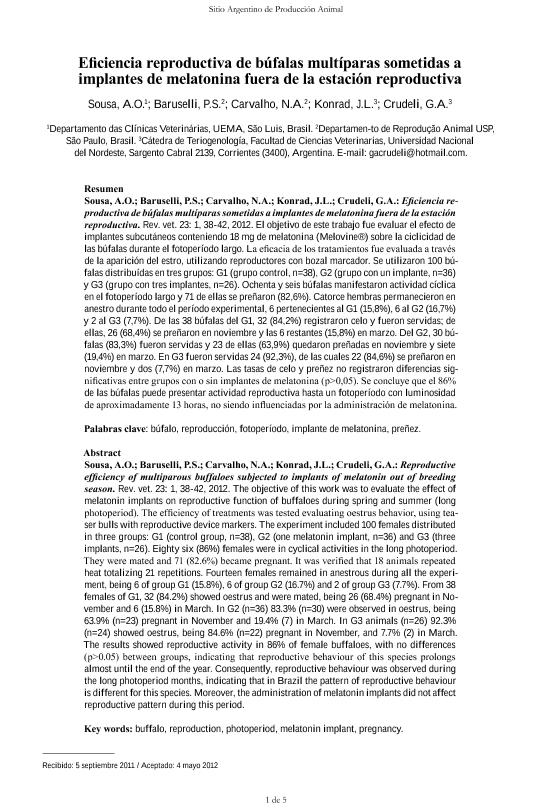Artículo
El objetivo de este trabajo fue evaluar el efecto de implantes subcutáneos conteniendo 18 mg de melatonina (Melovine®) sobre la ciclicidad de las búfalas durante el fotoperíodo largo. La eficacia de los tratamientos fue evaluada a través de la aparición del estro, utilizando reproductores con bozal marcador. Se utilizaron 100 búfalas distribuídas en tres grupos: G1 (grupo control, n=38), G2 (grupo con un implante, n=36) y G3 (grupo con tres implantes, n=26). Ochenta y seis búfalas manifestaron actividad cíclica en el fotoperíodo largo y 71 de ellas se preñaron (82,6%). Catorce hembras permanecieron en anestro durante todo el período experimental, 6 pertenecientes al G1 (15,8%), 6 al G2 (16,7%) y 2 al G3 (7,7%). De las 38 búfalas del G1, 32 (84,2%) registraron celo y fueron servidas; de ellas, 26 (68,4%) se preñaron en noviembre y las 6 restantes (15,8%) en marzo. Del G2, 30 búfalas (83,3%) fueron servidas y 23 de ellas (63,9%) quedaron preñadas en noviembre y siete (19,4%) en marzo. En G3 fueron servidas 24 (92,3%), de las cuales 22 (84,6%) se preñaron en noviembre y dos (7,7%) en marzo. Las tasas de celo y preñez no registraron diferencias significativas entre grupos con o sin implantes de melatonina (p>0,05). Se concluye que el 86% de las búfalas puede presentar actividad reproductiva hasta un fotoperíodo con luminosidad de aproximadamente 13 horas, no siendo influenciadas por la administración de melatonina. The objective of this work was to evaluate the effect of melatonin implants on reproductive function of buffaloes during spring and summer (long photoperiod). The efficiency of treatments was tested evaluating oestrus behavior, using teaser bulls with reproductive device markers. The experiment included 100 females distributed in three groups: G1 (control group, n=38), G2 (one melatonin implant, n=36) and G3 (three implants, n=26). Eighty six (86%) females were in cyclical activities in the long photoperiod. They were mated and 71 (82.6%) became pregnant. It was verified that 18 animals repeated heat totalizing 21 repetitions. Fourteen females remained in anestrous during all the experiment, being 6 of group G1 (15.8%), 6 of group G2 (16.7%) and 2 of group G3 (7.7%). From 38 females of G1, 32 (84.2%) showed oestrus and were mated, being 26 (68.4%) pregnant in November and 6 (15.8%) in March. In G2 (n=36) 83.3% (n=30) were observed in oestrus, being 63.9% (n=23) pregnant in November and 19.4% (7) in March. In G3 animals (n=26) 92.3% (n=24) showed oestrus, being 84.6% (n=22) pregnant in November, and 7.7% (2) in March. The results showed reproductive activity in 86% of female buffaloes, with no differences (p>0.05) between groups, indicating that reproductive behaviour of this species prolongs almost until the end of the year. Consequently, reproductive behaviour was observed during the long photoperiod months, indicating that in Brazil the pattern of reproductive behaviour is different for this species. Moreover, the administration of melatonin implants did not affect reproductive pattern during this period.
Eficiencia reproductiva de búfalas multíparas sometidas a implantes de melatonina fuera de la estación reproductiva
Título:
Reproductive efficiency of multiparous buffaloes subjected to implants of melatonin out of breeding season
Fecha de publicación:
05/2012
Editorial:
Universidad Nacional del Nordeste
Revista:
Revista Veterinaria
ISSN:
1668-4834
Idioma:
Español
Tipo de recurso:
Artículo publicado
Clasificación temática:
Resumen
Palabras clave:
BUFALOS
,
REPRODUCCION
,
FOTOPERIODO
,
MELATONINA
Archivos asociados
Licencia
Identificadores
Colecciones
Articulos(CCT - NORDESTE)
Articulos de CTRO.CIENTIFICO TECNOL.CONICET - NORDESTE
Articulos de CTRO.CIENTIFICO TECNOL.CONICET - NORDESTE
Citación
Sousa, A. O.; Baruselli, P. S.; Carvalho, N. A.; Konrad, José Luis; Crudeli, Gustavo Angel; Eficiencia reproductiva de búfalas multíparas sometidas a implantes de melatonina fuera de la estación reproductiva; Universidad Nacional del Nordeste; Revista Veterinaria; 23; 5-2012; 38-42
Compartir




